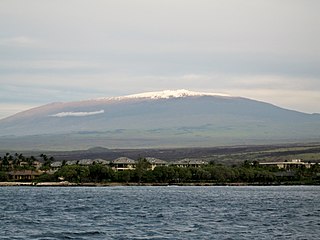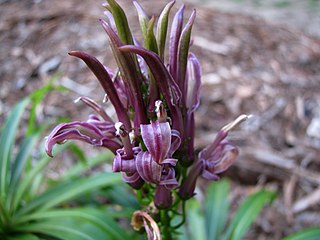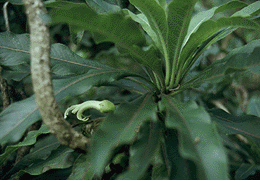
Mauna Kea is a dormant shield volcano on the island of Hawaiʻi. Its peak is 4,207.3 m (13,803 ft) above sea level, making it the highest point in Hawaii and the island with the second highest high point, behind New Guinea, the world's largest tropical island with multiple peaks that are higher. The peak is about 38 m (125 ft) higher than Mauna Loa, its more massive neighbor. Mauna Kea is unusually topographically prominent for its height: its prominence from sea level is fifteenth in the world among mountains, at 4,207.3 m (13,803 ft); its prominence from under the ocean is 9,330 m (30,610 ft), rivaled only by Mount Everest. This dry prominence is greater than Everest's height above sea level of 8,848.86 m (29,032 ft), and some authorities have labeled Mauna Kea the tallest mountain in the world, from its underwater base. Mauna Kea is ranked 8th by topographic isolation.
Located about 2,300 miles (3,680 km) from the nearest continental shore, the Hawaiian Islands are the most isolated group of islands on the planet. The plant and animal life of the Hawaiian archipelago is the result of early, very infrequent colonizations of arriving species and the slow evolution of those species—in isolation from the rest of the world's flora and fauna—over a period of at least 5 million years. As a consequence, Hawai'i is home to a large number of endemic species. The radiation of species described by Charles Darwin in the Galapagos Islands which was critical to the formulation of his theory of evolution is far exceeded in the more isolated Hawaiian Islands.

Kohala is the oldest of five volcanoes that make up the island of Hawaii. Kohala is an estimated one million years old—so old that it experienced, and recorded, the reversal of Earth's magnetic field 780,000 years ago. It is believed to have breached sea level more than 500,000 years ago and to have last erupted 120,000 years ago. Kohala is 606 km2 (234 sq mi) in area and 14,000 km3 (3,400 cu mi) in volume, and thus constitutes just under 6% of the island of Hawaii.

The Hawaiian lobelioids are a group of flowering plants in the bellflower family, Campanulaceae, subfamily Lobelioideae, all of which are endemic to the Hawaiian Islands. This is the largest plant radiation in the Hawaiian Islands, and indeed the largest on any island archipelago, with over 125 species. The six genera involved can be broadly separated based on growth habit: Clermontia are typically branched shrubs or small trees, up to 7 metres (23 ft) tall, with fleshy fruits; Cyanea and Delissea are typically unbranched or branching only at the base, with a cluster of relatively broad leaves at the apex and fleshy fruits; Lobelia and Trematolobelia have long thin leaves down a single, non-woody stem and capsular fruits with wind-dispersed seeds; and the peculiar Brighamia have a short, thick stem with a dense cluster of broad leaves, elongate white flowers, and capsular fruits. The relationships among the genera and sections remains unsettled as of April 2022.
Hesperomannia arborescens, the Lanai island-aster or Lanai hesperomannia, is a species of flowering plant in the family Asteraceae.

Colubrina oppositifolia, known as kauila in Hawaiian, is a rare species of flowering tree in the family Rhamnaceae endemic to Hawaii.

Adenophorus periens is a rare species of fern known by the common name pendant kihi fern. It is endemic to Hawaii, where it is known from one population in Puna on the island of Hawaii and a few occurrences on Kauai and Molokai. The fern occurs in wet mountain forests on volcanic slopes. It grows on trees. There are perhaps 2000 individual plants remaining. This is a federally listed endangered species of the United States.
Clermontia lindseyana is a rare species of flowering plant in the bellflower family known by the common name hillside clermontia. It is one of several Hawaiian lobelioids in genus Clermontia that are known as `oha wai. This plant is known only from Haleakalā, a volcano on the island of Maui, and Mauna Loa and Mauna Kea, volcanoes on the island of Hawaii. This is a federally listed endangered species of the United States.
Clermontia peleana is a rare species of flowering plant in the bellflower family known by the common name Pele clermontia. It is one of several Hawaiian lobelioids in genus Clermontia that are known as `oha wai. This plant is endemic to the island of Hawaii, where it is known from a few individuals. It is a federally listed endangered species of the United States.

Clermontia pyrularia is a rare species of flowering plant in the bellflower family known by the common names Hamakua clermontia and pear clermontia. It is one of several Hawaiian lobelioids in genus Clermontia that are known as ʻoha wai and haha. It is endemic to the island of Hawaiʻi, where there is one remaining wild population containing 15 individuals and several propagated individuals that have been planted in protected habitat. This is a federally listed endangered species of the United States.
Clermontia samuelii is a rare species of flowering plant in the bellflower family known by the common name Hana clermontia. It is one of several Hawaiian lobelioids in genus Clermontia that are known as `oha wai. This plant is endemic to Maui, where there are fewer than 250 mature specimens remaining. This is a federally listed endangered species of the United States.
Cyanea glabra is a rare species of flowering plant in the family Campanulaceae known by the common name smooth cyanea. It is endemic to Maui, where there are twelve plants remaining in the wild. It was federally listed as an endangered species of the United States with nine other Maui Nui endemics in 1999. Like other Cyanea it is known as haha in Hawaiian.
Cyanea procera is a rare species of flowering plant in the bellflower family known by the common name Molokai cyanea. It is endemic to Hawaii, where it is known only from the island of Molokaʻi. It is a federally listed endangered species of the United States. Like other Cyanea it is known as haha in Hawaiian.
Cyanea recta is a rare species of flowering plant in the bellflower family known by the common names upright cyanea and Kealia cyanea. It is endemic to Hawaii, where it is known only from the island of Kauai. It is a federally listed threatened species of the United States. Like other Cyanea it is known as haha in Hawaiian.
Cyrtandra giffardii is a rare species of flowering plant in the African violet family known by the common names forest cyrtandra and Giffard's cyrtandra. It is endemic to the island of Hawaii, where it grows on the slopes of Mauna Kea and Mauna Loa. A 1998 estimate places the total remaining population size around 1000 individual plants. It is a tree which grows 2 to 6 meters tall and bears white flowers. It was federally listed as an endangered species in 1994. Like other Hawaiian Cyrtandra it is called ha`iwale.
Dubautia latifolia is a rare species of flowering plant in the family Asteraceae known by the common name koholapehu. It is endemic to Hawaii where it is known only from the west side of the island of Kauai. Like other Dubautia this plant is called na`ena`e.
Phyllostegia warshaueri is a rare species of flowering plant in the mint family known by the common name Laupahoehoe phyllostegia. It is endemic to Hawaii, where it is limited to the island of Hawaii. It is a federally listed endangered species of the United States.
Drosophila ochrobasis is an endangered species of fly from Hawaii, in the species rich lineage of Hawaiian Drosophilidae. It is found on the Big island of Hawaii, and has historically been recorded from four of the five volcanoes, though it is now largely absent from most of those sites. This species is in the adiastola subgroup and is closely related to D. setosimentum, but male D. ochrobasis have strikingly different wing markings.

Clermontia montis-loa, or Mauna Loa clermontia, is a species of Hawaiian lobelioid endemic to the eastern windward slopes of Mauna Loa on the island of Hawai'i. Like other Clermontia, it is referred to as ʻŌhā wai in Hawaiian.

Clermontia hawaiiensis, the ʻŌhā kēpau, is a species of Hawaiian lobelioid endemic to Hawaiʻi island, where it grows in Hawaiian tropical rainforests. Like other Hawaiian lobelioids, it is highly susceptible to damage from invasive grazing mammals such as feral pigs.








